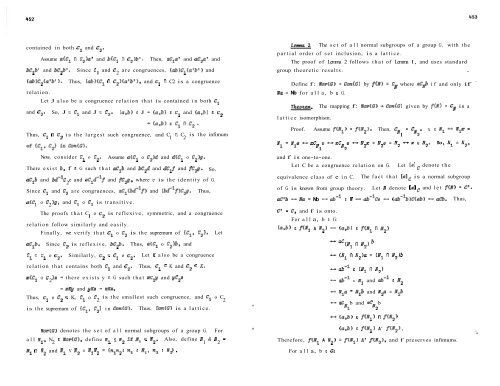Vol. 8 No 7 - Pi Mu Epsilon
Vol. 8 No 7 - Pi Mu Epsilon
Vol. 8 No 7 - Pi Mu Epsilon
Create successful ePaper yourself
Turn your PDF publications into a flip-book with our unique Google optimized e-Paper software.
contained in both C1 and C2.<br />
Assume a(Cl fl C2)a1 and b(Cl fl C2)b1. Then, aC1al and aC2a1 and<br />
bC1bl and bC2b1.<br />
(ab)C2(a'b1 1.<br />
relation.<br />
and C2.<br />
Since C and C are congruences, (ab)C1(aW) and<br />
1 2<br />
Thus, (ab)(Cl fl C2)(a1b1), and C1 fl C 2 is a congruence<br />
Let J also be a congruence relation that is contained in both Cl<br />
So, J c Cl and J c C . (a,b) e J + (a,b) e C, and (a,fc) e C2<br />
Thus, Cl n C is the largest such congruence, and C 0 C is the infimum<br />
1 2<br />
Lemma. 2.<br />
The set of all normal subgroups of a group G, with the<br />
partial order of set inclusion, is a lattice.<br />
The proof of Lemma 2 follows that of Lemma 1, and uses standard<br />
group theoretic results. -<br />
Define f: <strong>No</strong>r(G) + C dG) by f(N) = C where aC# if and only if .<br />
Na = Nb for all a, b e G.<br />
Themem.<br />
lattice isomorphism.<br />
The mapping f: <strong>No</strong>r(G) + Con(G) given by f(S) = C is a<br />
Proof. Assume f(Nl) = f(N2). Then, C = C x E N * Nlx =<br />
1<br />
<strong>No</strong>w, consider Cl o C2.<br />
Assume a(C1 o C2)d and d(Cl o C2)g.<br />
There exist b, f e G such that aClb and bC2d and dClf and fCg.<br />
aC1b and b d " ~ e and eC1d"f and fC2g, where e is the identity of G.<br />
2<br />
Since Cl and C2 are congruences, a~~(bd-~f) and (bd"f)C2g.<br />
a(C o C )g, and Cl o C2 is transitive.<br />
1 2<br />
Thus,<br />
The proofs that C o C2 is reflexive, symmetric, and a congruence<br />
1<br />
relation follow similarly and easily.<br />
Finally, we verify that C1 o C2 is the supremum of {CIS C2}.<br />
So,<br />
Let<br />
and f is one-to-one.<br />
Let C be a congruence relation on G. Let [el denote the<br />
equivalence class of e in C. The fact that [elc is a normal subgroup<br />
of G is known from group theory. Let N denote [el and let f(N) = C'.<br />
aC1b
















